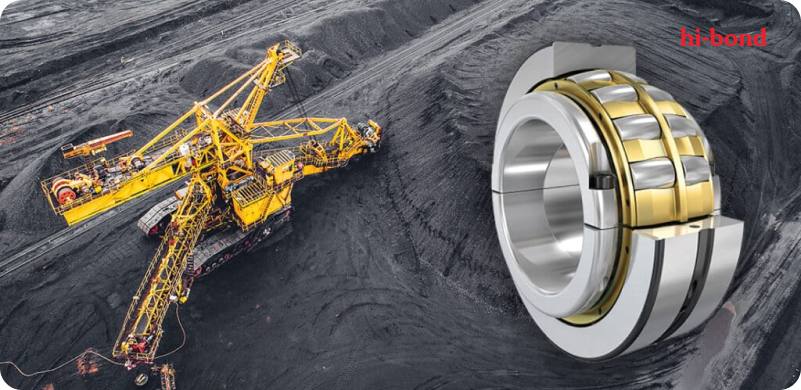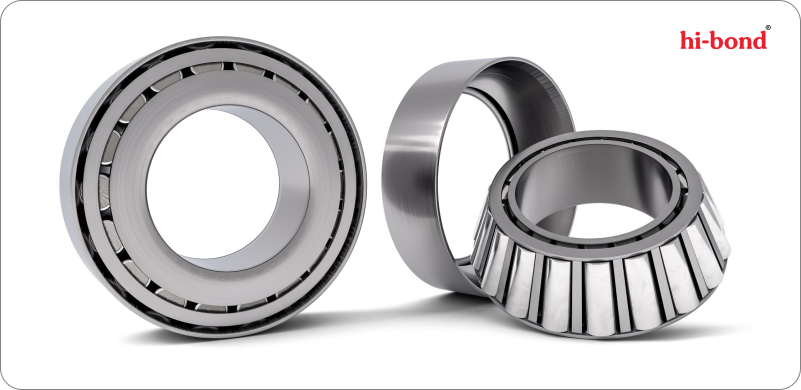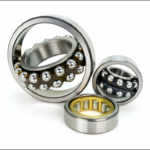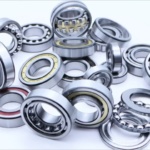Today, the mining industry is witnessing a major transformation powered by innovative mining bearings. These powerful components are reshaping the industry, providing the best support and enabling smooth movement for various equipment.
Operating in extreme environments, the mining industry faces many challenges, such as excessive temperatures, high altitudes, and chemical exposure. Hi-bond Bearings Pvt. Ltd, the best bearing manufacturer and supplier, leads the manufacturing and supplying of bearings found in mining equipment essential in mineral extraction, transportation, and processing.
Keep reading the post for valuable details on mining bearings with their repairs and modifications to suit industry-best mining operations.
Introduction to Mining Bearings
When talking about the mining and construction industry, the equipment operates in remote and demanding environments, running continuously and facing challenging conditions such as heavy loads with impacts, light loads with high-speed rotation, and heavy loads with low-speed rotation. Mining bearings used in these machines must be durable, long-lasting, and highly reliable to minimize downtime and ensure continuous operations.
Bearings and bushes suppliers offer advanced mining bearings designed with cutting-edge technologies. These bearings deliver extended life and high allowable speeds for increased productivity, reduced maintenance costs, and environmentally friendly operations, even in the harshest sites.
Type of Bearings for Mining Applications
Leading bearing manufacturers, like your trusted Hi-bond Bearings Pvt. Ltd offers a wide range of large bearings tailored to meet the requirements of the mining industry.
Heavy duty cylindrical and tapered roller bearings have been supplied for decades, serving various mining equipment, from low-slung underground miners to behemoth drag lines.
They are crucial components in gear reducers, supporting parallel shaft and planetary designs, and are essential for providing support and enabling movement in draglines, shovels, longwall millers, off-road dump trucks, and rock crushing equipment.
These industrial class bearings are designed to provide long in-service life and structural integrity to withstand impacts, overloads, and high-speed excursions. The range includes:
- Ball bearings
- Cylindrical roller bearings
- Tapered roller bearings
- Spherical roller bearings
- Thrust bearings
These mining bearings ensure durability and reliability for demanding environments worldwide.
Benefits Mining Bearings Provide with Applications Used

Mining bearings offer several important benefits for equipment and operations in the mining and construction industry.
Equipment Reliability and Uptime: Mining operations heavily depend on continuous and reliable machinery operation. Bearings are crucial in minimizing downtime due to component failure, ensuring the seamless operation of heavy machinery such as crushers, conveyors, grinding mills, and excavators to maximize productivity.
Lowered Friction and Wear: In harsh mining environments where dust, dirt, and debris are common, properly sealed and lubricated bearings reduce friction between moving parts. It prevents excessive wear and extends the lifespan of mining equipment, contributing to sustained operational efficiency.
Load Support: Mining machinery often encounters heavy loads, shocks, and vibrations. Bearings provide essential load support by distributing weight and stresses evenly across components. It helps prevent damage and extends the operational life of mining equipment, ensuring long-term reliability.
Energy Efficiency: Well-maintained bearings contribute to energy efficiency by reducing friction and lowering energy consumption and operating costs. These bearings keep operational sustainability and contribute to cost savings in mining operations.
Safety: Mining operations can be hazardous, and unexpected equipment failures can lead to accidents. Reliable bearings help ensure the safe operation of machines, protecting equipment operators and other personnel working in the vicinity, thereby prioritizing safety in mining environments.
Environmental Impact: Reliable bearings and bushings lead to fewer equipment replacements and less waste generation, aligning with the increasing focus on sustainable approaches in the mining industry. They contribute to reduced environmental impact and support environmentally conscious mining operations.
Cost Savings: While bearings represent a relatively small investment compared to mining equipment, their failure can lead to costly repairs, replacements, and production interruptions. Regular maintenance and high-quality mining bearings can lead to long-term cost savings, aligning with the goal of operational efficiency and cost-effectiveness in mining operations.
Advancements in Bearing Technology for the Mining Industry
The mining industry has witnessed noteworthy advancements in bearing technology, driven by the increasing need for enhanced efficiency, reliability, and safety in mining operations.
These advancements encompass various essential areas:
Advanced Materials for Production
Bearings are now being developed using advanced materials that offer improved durability, corrosion resistance, and temperature tolerance. Examples include ceramic bearings and specialized coatings that contribute to extended lifespans and enhanced performance in demanding mining environments.
Sealing Technology
Advancements in sealing technology play a crucial role in preventing contaminants from entering bearings, especially in harsh mining environments. These developments help extend bearing life and reduce maintenance requirements, ensuring sustained operational efficiency.
Smart Bearings
Integration of sensors into bearings allows for real-time monitoring of bearing health and performance. This data can be used to predict potential failures, optimize maintenance schedules, and improve overall operational efficiency, contributing to enhanced safety and reliability in mining operations.
Lubrication Needs
Improved lubrication techniques and materials are being developed to enhance the performance of bearings in mining operations. Proper lubrication is essential for minimizing friction and wear, ensuring prolonged equipment lifespan and reduced operational costs.
Design Optimization
Mining bearings are being designed using advanced computational techniques to ensure optimal load distribution, reduced friction, and improved overall performance, aligning with the industry’s focus on operational efficiency and reliability.
Reduced Environmental Impact
Bearings with reduced friction and energy consumption contribute to more environmentally friendly operations, aligning with the mining industry’s increasing focus on sustainability and environmental responsibility.
Automation and Robotics
As mining operations become more automated and reliant on robotics, bearings that can withstand the unique stresses of these applications are being developed, ensuring seamless integration and reliable performance.
Remote Monitoring and Maintenance
These bearing products from the bearing manufacturing company come equipped with remote monitoring capabilities that enable maintenance teams to assess their condition without being physically present at the site. It can lead to quicker response times and reduced downtime, enhancing operational efficiency and equipment reliability.
These advancements in bearing technology reflect the industry’s commitment to achieving higher efficiency, reliability, and safety in mining operations, ultimately contributing to improved overall performance and sustainability.
Large Bore Bearing Repairs and Modifications in the Mining Industry
Large bore bearings are popular in supporting heavy loads and ensuring smooth rotation in mining equipment. Due to the harsh environments of the mining industry, these bearings require repair or replacement during their usable life.
Various bearing modifications are available, such as clearance changes, straight-to-taper bore (1:12 or 1:30), anti-rotation/locating holes or notches, lubrication holes and grooves (W33 & W26), and the addition of lifting holes.
Repairing and modifying bearings is often a more cost-effective solution than purchasing new ones, particularly for large and expensive bearings, leading to substantial cost savings for mining companies.
- Quicker Repairs: In an industry where time is money, repairs can be completed faster than waiting for new replacements. Reducing equipment downtime is crucial for maintaining operational efficiency.
- Sustainability: Repairing bearings aligns with sustainability efforts by reducing the demand for new manufacturing and associated resource consumption, contributing to environmentally responsible practices in the mining industry.
To repair large bore bearings, follow these steps and considerations and ensure effective maintenance and optimal performance:
- Thoroughly inspect the damaged bearing to identify the extent of the damage and the possible underlying causes.
- Carefully disassemble the bearing, documenting the process to ensure proper reassembly.
- Clean all components thoroughly to remove contaminants, old lubricants, and debris.
- Consider using non-destructive testing methods, such as ultrasonic or magnetic particle testing, to identify hidden defects or cracks in critical components.
- Based on the extent of the material damage caused, consider repair options such as re-machining, overlay welding, or replacing damaged bearing components.
- Recondition the bearing components through grinding or lapping to restore proper geometry and surface finish if possible.
- Use high-quality replacement parts and ensure they meet or exceed the original specifications.
- Implement a robust lubrication program, ensuring that the bearing receives the appropriate type and amount of lubricant.
- Ensure proper bearing and associated components alignment to prevent uneven loading and premature wear.
- Follow manufacturer guidelines for proper installation, including torque specifications and preloading, to ensure optimal performance.
- Implement a comprehensive monitoring program using vibration analysis, temperature monitoring, and other relevant techniques to detect early signs of potential issues.
- Maintain detailed records of the repair process, including inspection reports, repair procedures, and any modifications made to the equipment.
- Ensure that personnel involved in the repair process are well-trained and follow safety protocols to prevent accidents and injuries.
- Periodically review and update maintenance practices based on performance data and industry best practices to continuously improve the reliability of large bore bearings.
The Increased Use of Tapered Roller Bearings in Mining Equipment

Tapered roller bearings are used in various industries, particularly in the mining sector, owing to their distinctive design and capabilities.
Hi-bond Bearings Pvt. Ltd, the bearings and bushes suppliers, provide bearings used in mining equipment, including rock crushers, shaker screens, hoists, and conveyors, due to their ability to effectively handle heavy, shock, and demanding environmental conditions.
- Handling Heavy Loads: Mining equipment, such as crushers, conveyors, and ore processing machinery, frequently encounters substantial loads from extracted materials. Tapered roller bearings are explicitly engineered to manage both radial and axial loads, making them exceptionally well-suited for applications where heavy loads are a persistent challenge.
- Resisting Shock Loads: Mining operations often entail sudden and unpredictable shock loads due to the impact of materials and equipment. Tapered roller bearings are adeptly designed to distribute these loads more evenly, thereby improving the resilience of mining equipment.
- Securing Durability and Longevity: The design of tapered roller bearings enables them to accommodate misalignment and shaft deflection, which are common occurrences in harsh mining environments, thus contributing to their durability and longevity.
- Adapting to Temperature Variations: Mining environments frequently feature extreme temperature variations, particularly in underground mines. You can also find spherical and tapered roller bearings specifically engineered to handle high and low temperatures, ensuring consistent performance across diverse environmental conditions.
- Shielding Against Contaminants: Mining environments often subject bearings to dust, dirt, moisture, and those other contaminants that undermine bearing performance. Tapered roller bearings can be equipped with seals and shields to safeguard against these detrimental contaminants.
- Minimizing Maintenance Downtime: The robust nature of tapered roller bearings can result in longer intervals between maintenance and replacement, reducing maintenance downtime and improving the overall operational efficiency of mining activities.
Boost Mining Operations with Quality Bearings Now!
Mining bearings are essential for the smooth operation of heavy machinery in the construction and mining industry. They provide essential support, reliability, and efficiency. Their ability to minimize friction, reduce wear, and enhance safety and productivity is paramount.
Check out the extensive inventory of bearings and bushings from Hi-bond Bearings Pvt. Ltd. that are tailored to the specific needs of the mining industry. Contact our sales professionals to discover the ideal bearing solution for your customers and learn more about how we can support your business.




